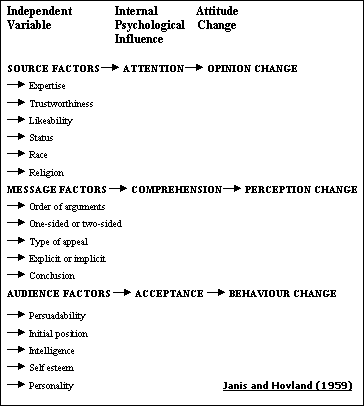Janis and Hovland (1959)
Janis and Hovland (1959) in the Yale Communication Research Programme investigated the independent variables of source, message and audience (target) and measured attitude change with respect to changes in opinion, perceptions, valuations and behaviour. They found that source factors influenced the amount of attention paid by listeners to the communication; message factors influenced the comprehensibility of the message for the audience; and audience factors could influence attitude change and thus behaviour. Their model below illustrates the conditions of their independent variable, and how different types of persuasive communications can have a psychological influence on us to alter or change how we think, feel and behave.
 |
Jung, Carl
Jung left Freud's inner circle in Vienna in 1913 because he disagreed with the emphasis Freud placed on sex. He then went on to establish his own ideas including the idea that consciousness was compsed of our own consciousness and the collective unconscious. This collective unconscious is like 'genetic memory' passed down through a species giving us an in-built survival machanism (such as babies not crawling off of vertical drops).


| Dyslexia
& Myers-Irlen syndrome Research into dyslexia and Myers-Irlen syndrome suggests that changing the background colour upon which words are written can often benefit the reader. If you feel this applies to you please select your preferred colour from the DMI EasiReader © below. Click here to go to the DMI EasiReader information page |
[
Sign
my Guestbook] - [Read
my Guestbook ]